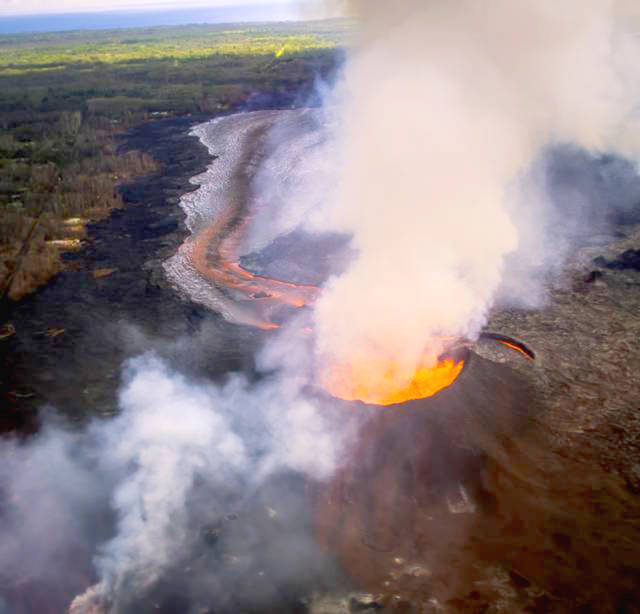Lava Tree State Monument and MacKenzie State Recreation Area “are closed and will likely remain so for a very long time,” the state parks chief said Sunday.
“Pele is in control now,” state Parks Division Administrator Curt Cottrell said in a written statement. “She already reclaimed Kalapana State Park back in 1990 and may well decide to perform substantial makeovers to Lava Tree and/or MacKenzie.”
MacKenzie and nearby Malama Ki Forest Reserve appear to be significantly made over in photographs taken Thursday and released Sunday by the Department of Land and Natural Resources.
Lava Tree and MacKenzie, both in lower Puna, have been closed since shortly after the eruption began May 3 in Kilauea’s lower East Rift Zone. MacKenzie is adjacent to the first ocean entry. According to DLNR, both parks were closed for public safety.
State Parks Hawaii Island Supervisor Dean Takabayashi visited Lava Tree on Monday and noted damage to the restrooms and park walkway, likely caused by the magnitude-6.9 earthquake on May 4.
“We have to keep these parks closed because they’re close to lava and subject to gas emissions from the eruption. We don’t know yet what other dangers have been created by the earthquake and six-week old eruption,” Takabayashi said.
DLNR Division of Conservation and Resources officers have written dozens of citations to sightseers caught at Lava Tree and MacKenzie. They’ll continue heavy patrols in both parks to keep people out of restricted areas for their own safety, the department said.
Two Hilo residents, 32-year-old Alexander White and 41-year-old Ruth Moss, were cited Saturday by a DLNR enforcement officer on Highway 137 near MacKenzie State Recreation Area.
According to DLNR, White and Moss were with two children walking along the shoreline at Coconut Grove at 12:45 p.m.
The officer reported that none was wearing masks and sulfur dioxide in the area had reached 2.3 parts per million earlier in the day. The federally-recognized safe level for SO2 is less than 2.0 ppm.
All were escorted back to the roadblock on Highway 137 and the adults were cited.
Under a supplemental emergency proclamation signed by Gov. David Ige, loitering in a restricted lava zone is punishable by up to a year in jail and a fine of up to $5,000.
These citations bring the number of people cited by DLNR and county police since the eruption began on May 3 to 76.
About half of the 1,514-acre Malama Ki Forest Reserve has been closed for weeks. The lava has burned much of the forest and volcanic emissions have defoliated hundreds of trees. The reserve served as a habitat to sub-populations of native forest birds which have developed unique resistance to avian pox and avian malaria.
“We would hate to lose that genetic pool,” said DLNR Division of Forestry and Wildlife Hawaii island Branch Manager Steve Bergfeld. “Due to current and further expected losses of Malama Ki’s habitat, populations of wildlife may no longer persist, rapidly decline, or become further fragmented and/or contract in range.”
The eruption also has destroyed the Wai‘opae Tidepools Marine Life Conservation District. Less than 1 percent of the marine environment in Hawaii is fully protected by these districts, so the loss of Wai‘opae is extremely significant, DLNR said.
The eruption is adding new acreage to the island, and newly created land, by law, becomes what DLNR called “state unencumbered land” and falls under the jurisdiction of the DLNR Land Division.
“This continuing eruption is changing the way DLNR and its division’s manage public lands in the lower Puna District,” Board of Land and Natural Resources Chairwoman Suzanne Case said. “There is tremendous alteration of the landscape on a broad scale and daily basis. Most dramatic is the complete lava inundation of Kapoho Bay including the covering of the Wai‘opae Tidepools ….”


